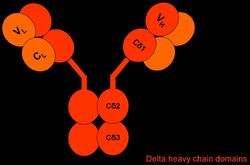Immunoglobulin D
(Redirected from IgD)
Jump to navigation
Jump to search
Overview
Shortened to IgD.
IgD is present in ruminants, pigs, dogs and rodents but has not been identified in horses, cats, rabbits and chickens. It is mainly expressed on the surface of B-cells i.e. it is never secreted.
Structure
IgD is Y-shaped. In rodents, it has two δ heavy chain constant regions, whereas other mammals have three. IgD has a long hinge region and no disulfide bonds.
Function
IgD is only expressed in association with IgM. It is thought to be important in B-cell development, although it has been shown in δ chain knockout mice (so they have no functional IgD) do not have any noticeable defects in immune function.
Interestingly IgD serum levels increase in allergic reactions, although it is not known why this is.
Links
| Originally funded by the RVC Jim Bee Award 2007 |
Error in widget FBRecommend: unable to write file /var/www/wikivet.net/extensions/Widgets/compiled_templates/wrt6962f289373342_10065656 Error in widget google+: unable to write file /var/www/wikivet.net/extensions/Widgets/compiled_templates/wrt6962f2893c7b23_05196381 Error in widget TwitterTweet: unable to write file /var/www/wikivet.net/extensions/Widgets/compiled_templates/wrt6962f289443b91_78986489
|
| WikiVet® Introduction - Help WikiVet - Report a Problem |

